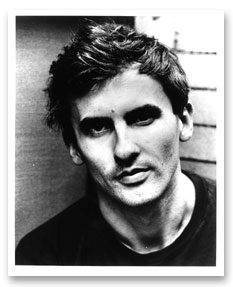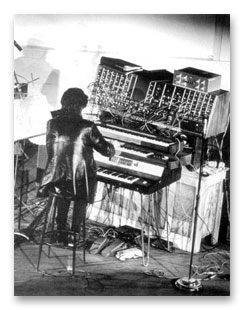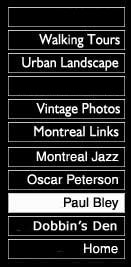|
|
|
|
|
|
|
Paul Bley
|
|
|
 |
|
|
Paul Bley was barely into his twenties when he left Montreal for New York City, yet he had already played with Charlie Parker and subbed for Oscar Peterson at Montreal’s Alberta Lounge.
Stopping Time is the story of Paul Bley’s odyssey through the most turbulent years in modern jazz. A successful bebop musician throughout the 1950s, he honed his talent in the bands of Charlie Parker, Lester Young, Charles Mingus, and Sonny Rollins. Yet, it was in a Los Angeles nightclub that Paul Bley found his true direction when two young musicians named Ornette Coleman and Don Cherry sat in with his band. As soon as they started to play, Bley knew that this was the music he had been looking for. |
|
|
|
Paul Bley in New York, late sixties.
Photo by Sy Johnson
|
|
|
|
Returning to New York with his first wife, composer and arranger Carla Bley, he became a central figure in the 1960s jazz revolution. Using one of the very first Moog synthesizers, he explored, with Annette Peacock, the areas between jazz, popular song, and sheer electronic sound. In the 1970s Bley toured North America, Europe, and Japan playing solo piano and leading trios with musicians such as Gary Peacock, Paul Motian, Dave Holland, and Barry Altschul. In 1974, Paul Bley and his wife Carol Goss formed their own record label, Improvising Artists, and recorded Sam Rivers, Sun Ra, and a young unknown guitarist named Pat Metheny.
Paul Bley continues to maintain a hectic pace of touring around the world and recording albums. When he is not touring, he lives with his wife, artist Carol Goss, and their family, in upstate New York.
Paul Bley on Synthesizers, Moog and Peacock
When improvisers left their previously acoustic domain and took up electricity, the intention in many cases was to make a literal translation of the acoustic music to electric. The inclusion of this new wealth of timbres produced an unexpected richness. Jaco Pastorius, who unlike bassist Stanley Clark, chose to ignore the difficulties of mastering the acoustic bass because he believed the sound of the electric bass to be equally as valid as that of the acoustic bass.
In my case, the change from piano to electric keyboards, including the first primitive synths was to lead to results that I could not have fully predicted. One has only to examine the evolution of the sound of the electric guitar to realize that the sound an instrument makes may forever change the future direction of the music to be made on that instrument.
In ensemble playing the thrill of loosing oneself in an electric universe where the players may not be able to tell who is doing what presented opportunities for real group integration. Unfortunately many of my peers chose to ride the wave of instant popularity and large audiences that this electric sound offered, completely ignoring the advances of free jazz.
In 1969, I did an interview for Downbeat Magazine. At the end of the interview, the writer casually asked what I thought about the new keyboard synthesizers. At this time, the keyboard had just been added to the synthesizer, so it was now perceived as being in my domain.
I said, "What's a keyboard synthesizer?"
He told me. Now I was interviewing him.
My next question was, "How do I get my hands on one?"
Bob Moog had just opened a factory in Trumansburg, New York, in the Finger Lakes district. I found out that there were only a few production models of the Moog synthesizer in existence, and that to get into that game you needed about twelve grand. But I decided I had to get this instrument.
When I phoned Trumansburg it sounded even more difficult. In fact, there was only one production model in the factory, and several pianists and their wives and children had emigrated to Trumansburg, just because Bob would let them play it at three o'clock on Thursdays.
I sat down and wrote a script about a luncheon date between Paul Bley and Robert Moog. Although I'd never met the man, at the beginning of this one-act play I said "Hello Bob," and he said "Hello Paul", and at the end I drove off with a Moog synthesizer.
I called him up and told him I would like to come to Trumansburg to see him. He'd heard of me, at least enough to say come on up.
I understood that the synthesizer was a miniaturization of an electronic music studio, where composers laboriously spliced together hundreds of pieces of recording tape to create an electronically conceived musical composition. I pointed out to Bob that in reducing this roomful of equipment down to the size of a coffee table and adding a keyboard, he had not made any allowances for real-time performance. And I put it to Bob that his company was doomed to failure unless he had the input of a performing musician.
Bob went for it, but said that since there was only one production model in existence, he would have to ship it to me later.
I said, "That's not necessary, Bob. I have my rented station wagon just outside the door and if you grab a corner of the synthesizer we can carry it outside right now."
|
|
|
 |
When we got back to New York there were certain problems to be solved, since there was no manual. Problem number one: how do you turn it on? Number two: How do you get it to make a sound? Number three: How do you get an attack and decay? Number four: How do you filter the sound?
This instrument required patching phono plugs between two places to make a connection. There were a million choices. For example, I learned that there were three kinds of vibrato: pitch vibrato as in a violin tremolo; volume vibrato, as if turning the volume knob up and down quickly; and timbre vibrato, as in turning the filtering knob up and down quickly. Since my hands were fully occupied with the keyboard and the patching, I had the luxury of designing twelve foot pedals for controlling these parameters.
In fact, only the instrument knew what it could do. It just sat there, pregnant with information. |
|
|
Paul Bley performing on his 'portable' Moog synthesizer at Philharmonic Hall, New York City, December 26, 1969. From Stopping Time. |
|
It took me and Annette two years to get to the point where we could give a performance on it. Finally we found sound one. That was a nightmare, because once we'd found sound one, we had to go back and start again to find sound two. We literally spent two years or so drawing charts of the face of the instrument and the patch cording that was required for each desired sound and treatment. I had pretty much decided early on that I wanted the keyboard synthesizer to do things that the piano couldn't do.
With the synthesizer band we made some records. Between April 1969 and October 1971 I made ten synthesizer records, of which Annette Peacock did voice synthesis on eight, one of which she is the leader on.
We played at the Jazz Workshop in Boston for a week, Barry Altschul and myself and a bassist, with this monophonic instrument with no memory. For a week! It was very hot stuff. I made tapes of it, but there was some very raw synthesizer playing which we decided was too far out to be issued. As our technology grew I found myself with several keyboards at my disposal. Photographs from that period show me stacking them. At that time there was no precedent for putting one keyboard on top of another--what we now call the keyboard sandwich. I had to think of that by myself.
There was no difference between the electric music and any of the free jazz we played acoustically. We didn't bother using the instrument to change the music, we were just hoping to be able to do some things that you couldn't do on acoustic instruments.
Annette assembled an instrument from additional Moog synthesizer modules that she could trigger using her voice, choosing the sounds she liked. She was plugging voice microphones into jacks that were looking for oscillator signals. That took even more work and the whole system became even less stable, because the instrument had zero memory. But she got some wonderful things.
I remember fondly a concert at the Village Vanguard. I had the synthesizer on the stage, a trio waiting to perform, an audience waiting for us to begin, and I was on the floor looking up under the synthesizer with a pocket flashlight and a screwdriver and the house mike, asking the audience to please bear with us. Max Gordon told me three things: get out, stay out and don’t come back. I haven't played the Vanguard since.
After doing the first live performance ever done with audio synthesizer and voice treatment at Philharmonic Hall in Friday on December 26th.1969 at 8:30PM, Annette and I received an offer to take the show to Europe. I should have learned my lesson while I was lying on the stage of the Vanguard, but I was so excited about this instrument, that I accepted the offer and went on the road.
An excerpt from Stopping Time: Paul Bley and the Transformation of Jazz. Copyright 1999 Paul Bley and David Lee.
|
|
|
 |
|
|
|
|
|
|
|
|
|
|
|
|
|
|
|
|
|
|
|
|
|





